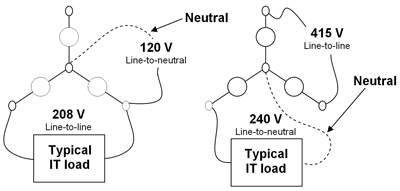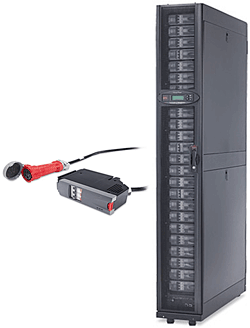Boosting data center voltage increases efficiency
Using a 240/415-V distribution system instead of 120/208-V can save cost and floor space
BY VICTOR AVELAR
APC by Schneider Electric, West Kingston, RI
http://www.apc.com
An unmistakable theme in this recession has been to do more with less. IT managers are pressured by executive management to find solutions that save operational costs while improving the company’s “green” image. In this regard, there’s one particular solution I consider low- hanging fruit 240-V distribution to the racks. This type distribution may not seem familiar, but if I had said, “230-V distribution to the rack,” any IT manager who has traveled to a data center in Europe would at least recognize this type of voltage distribution.
What they may not realized is that, compared to traditional 120-V distribution, this proposed distribution is more efficient, costs less to operate, and eliminates the need for transformers in the data center. Best of all it can be implemented along side the existing data center power distribution. Note that the only difference between the European 230-V distribution and the proposed 240-V distribution is 10 V that’s it.
Voltage recap
It might help to get a quick recap of line-to-neutral and line-to-line voltage. Line is defined as any one of the hot or live wires in a three-phase distribution system. In North America, typical IT loads draw their power either from a line-to-neutral voltage of 120 or line-to-line voltage of 208, while the proposed distribution provides a line-to-neutral voltage of 240. This is shown in Fig. 1; common notation for indicating voltage distribution is xxx / yyy where xxx is the line-to-neutral voltage and yyy is the line-to-line voltage.

Fig. 1. Difference between three-phase 120-V distribution and 240-V distribution.
It is important to recognize that when comparing the line to-neutral voltages of both distribution methods, the comparison should be between 120 V and 240 V and not between 208 and 240 V. This line-to-line and line-to-neutral difference becomes readily apparent when the power capacity for a for a three-phase branch circuit is calculated for each distribution method.
For example, assume a three-phase 20-A circuit is provided to a rack of servers. The power capacity for the 120-V line-to-neutral distribution method is calculated as (20 A x 120 V x 3 = 7.2 kW), while the capacity for the 240 V line-to-neutral distribution method is calculated as (20 A x 240 V x 3 = 14.4 kW).
240-V distribution
Given the same circuit current rating, the 240-V distribution provides 100% more power than the 120-V distribution. This increases the power density capability per rack without adding extra circuit breakers as would be the case with the 120/208-V distribution. These extra breakers present additional points of failure resulting in decreased data center reliability.
Consider now the same comparison except that this time the branch circuit power capacity is fixed at 10 kW. The power capacity for the 120-V line-to-neutral distribution is calculated as (27.7 A x 120 V x 3 = 10 kW), while the capacity for the 240-V line-to-neutral distribution is calculated as (13.9 A x 240 V x 3 = 10 kW). Given the same power, the 240-V distribution method provides the same power capacity with nearly half the current required by the 120-V distribution method.
This significant difference in current requires the branch circuit wires in the traditional North American system to be 300% larger in terms of their size and weight. Even more important is the savings in transformers. The PDU isolation transformers can be eliminated.
The PDU transformers are required in North America to change the voltage from the UPS output of 277/480 V down to the 120/208-V utilization voltage. In the rest of the world, the 230-V/400-V UPS output is used directly by the IT loads (no transformer required). Similarly, the proposed distribution eliminates distribution transformers and supplies the IT loads with 240 V.
In a North American data center with high-density racks, a significant amount of space that would be available for racks is consumed by PDUs. In addition, PDUs would make up a large percentage of the weight on the raised floor. These impacts were much lower in data centers of the past which operated at approximately 2 kW per rack.
Therefore the benefit of using this new power distribution approach increases dramatically as the rack power density increases. If an existing UPS is supplying 480 V to the data center, an auto transformer is used to change the UPS output voltage from 277/480 V to 240/415 V in the proposed method.
While it appears that this transformer replaces the PDU transformers, in fact it is 90% smaller, less expensive, and sized to the UPS capacity, in contrast to the PDU transformers, which as a group are typically sized at 1.5 to 3 times the UPS capacity. This auto-transformer can be outside the data center server space, that is, electrical room, which further conserves data center space. The capital cost savings in isolation transformers can be on the order of 50% in a new data center build, which includes the cost of the auto-transformers.
Since there is no isolation transformer, a 240-V PDU only occupies half the footprint of a standard IT rack. It allows rack power distribution to be reconfigured by swapping out power cables for higher power capacity. Power metering is built into the circuit breaker module so that the new module is automatically recognized by the PDU.

Fig. 2. Example of a 240-V PDU.
Comparing old and new
A comparison of the traditional 120/208-V power distribution design with the 240/415-V design was performed based on an actual customer’s data center. Their data center was 2,175 ft2 and consisted of two redundant modular UPSs at 600 kW each. The data center load was 30% (15% on each redundant UPS). A total of 104 racks ranged in density from 1.6 to 6.5 kW each.
Some of the highlights of the study include a weight savings of 90% due to eliminating all the PDU isolation transformers, 32% space savings including the service clearances, and 91% electricity savings which includes the cost of cooling. Although the study assumes a new data center build, it does provide some evidence as to the potential savings for a retrofit project.
Most IT equipment will accept 240 V, but some older equipment may require 120 V and need a traditional power feed or a step-down transformer off the 240-V distribution. The appropriate connectors for use with 240-V circuits are IEC C13 and C19 types. This is the power cord connector provided by most OEM server manufacturers with rack-mount servers and storage devices. Therefore, most high-density servers are already provided with the appropriate connector for use with a 240-V system. ■
Advertisement
Learn more about APC by Schneider Electric





